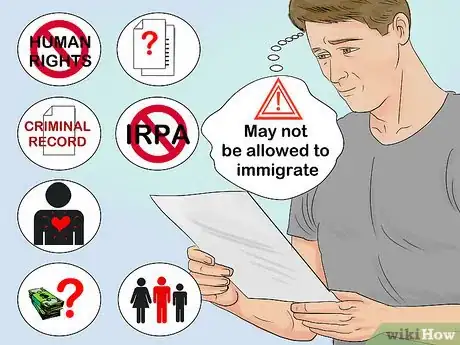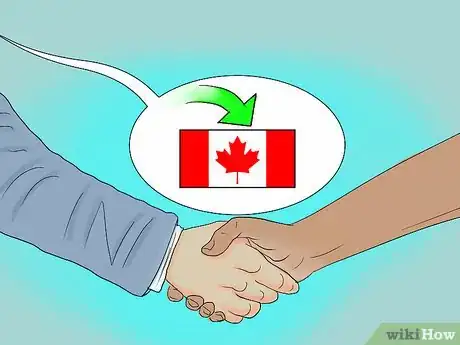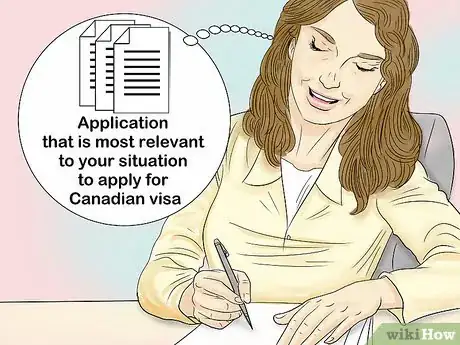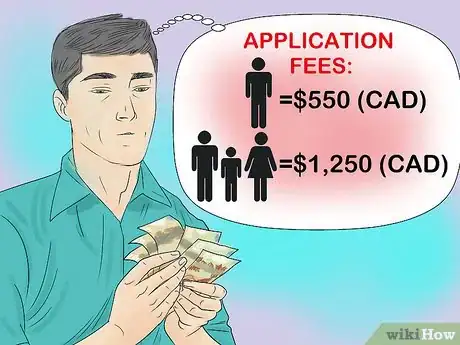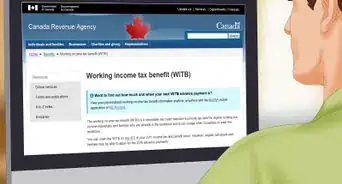This article was co-authored by Timothy Morson. Timothy Morson is a Canadian Immigration Specialist and a former Canadian Diplomat. With over 30 years of experience, Timothy specializes in Canadian immigration programs, immigration management, employer compliance, and international mobility. He holds a BA in Political Science from Concordia University and an MA in Journalism from Western University. Timothy is accredited by the Immigration Consultants of Canada Regulatory Council (ICCRC), Immigration Quebec, and is a member of the Order of Chartered Administrators of Quebec (Adm.A). He works to help people and companies around the world achieve their immigration goals.
There are 13 references cited in this article, which can be found at the bottom of the page.
wikiHow marks an article as reader-approved once it receives enough positive feedback. This article received 57 testimonials and 98% of readers who voted found it helpful, earning it our reader-approved status.
This article has been viewed 1,493,656 times.
Approximately 250,000 people move to Canada each year. There are multiple paths to legally move to Canada and many people will qualify for at least one of them. Detailed step by step by step instructions on making your move to Canada follow.
Steps
Gaining Entry to Canada
-
1Check your eligibility to move to Canada. Before you go forward with your plans to move to Canada, you should check your eligibility. You may not be allowed to immigrate for one of many reasons. These reasons include:
- human or international rights violations
- criminal record
- health
- financial reasons
- misrepresentation
- non-compliance with IRPA (Immigration Refugee Protection Act)
- having an inadmissible family member[1]
-
2Consider the different types of legal residency in Canada. It is important to go through a legal channel to gain entry to Canada. Otherwise you will be breaking the law and you may be deported. There are several ways that you can apply to be a Canadian resident.[2] These include:[3]
- Express Entry for Skilled Workers. The skilled worker class is considered by many to be the most effective way to gain Canadian residency. People with at least 12 months of full time managerial, professional, or skilled trade work experience may apply under this category.[4] When applying through this class, officials will consider your age, work experience, education, and the field in which you will be working.
- Business Start-up or Investor. These types of visas are meant for individuals who are entrepreneurs, own their own businesses, or who are professional investors. Investors who wish to apply through the investor channel must have a net worth of at least $10 million Canadian Dollars or more.[5]
- Provincial. Provincial class residency occurs when a specific Canadian province selects you to move to it. This form of residency is relatively rare.
- Family Sponsored. In the family class, your family members who already live in Canada can agree to sponsor your immigration to the country.
- Spouse Sponsored. If your spouse is a Canadian citizen or permanent resident over the age of 18 they can sponsor you to live in Canada as a permanent resident. You must be able to prove that the marriage was genuine and not just for gaining residency.
- Quebec-Selected. Quebec-selected immigration is similar to Provincial class residency, except it is the Provincial government that selects you on behalf of the Federal Government. It is designed for students, business people : including the Quebec VIP Investment visa Program , temporary workers, families, and refugees who only want to move to Quebec.
- International Adoption. In the international adoption class, current Canadian citizens who have adopted a baby or child from another country can secure the child's Canadian residency.
- Refugees. People who are fleeing their home countries for safety reasons may also apply for residency by completing a refugee application. Sponsorship to help with the cost of the application and relocating to Canada is also available.[6]
- Caregivers. If you are coming to Canada for the purpose of caring for a Canadian resident or citizen, then you may be able to apply for a Caregiver visa.
- Self-Employed. If you work for yourself, then you may be able to apply for a visa as a self-employed individual. Keep in mind that you may have to prove that you have an income of at least $40,000 per year and that you could continue to earn as much living in Canada.[7]
Advertisement -
3Complete the appropriate application. Choose the application that is most relevant to your situation to apply for your visa. For example, if you are self-employed and planning to move to Canada, then you would need to fill out a different application than someone who is planning to move to Canada as a caregiver for someone else.
- Skilled workers can complete an Express Entry profile online if you want to speed up the process of moving to Canada.[8] This profile includes information about yourself, your language skills, and your credentials. After you complete your Express Entry profile, you will also need to register with the Government of Canada’s Job Bank (unless you already have a job offer).[9]
- If you are applying for a self-employed, start-up visa, Quebec-selected skilled worker, family sponsored visa, or a provincial visa, then you will have to mail in your application.[10]
-
4Pay the application fee. The application fees can be quite high, especially if you will be requesting entry for a spouse and other dependents as well. For example, the application fee for an Express Entry application for an individual would be $550 Canadian dollars. However, if you are bringing a husband or wife and child as well, then the total application fee would be $1,250 Canadian dollars.
- Make sure that you pay your application fee in full or your application may not be processed.
-
5Wait for your visa to arrive. Keep in mind that it can take a while to get a response on your application. Even if you apply using the Express Entry form, you may have to wait for up to six months to get a response.[11] Therefore, make sure that you apply as soon as you know that you want to move to Canada. Don't wait until a month or a week before you want to go, get the application in right away.
- If your application is denied, then you will have to reapply and you should only do so if your situation changes in a significant way. You cannot appeal the decision.[12]
Making the Transition
-
1Gather important documents before you move. When you move, you will need to have certain official documents with you in order to gain entry to Canada. You'll need:
- A Canadian immigrant visa and Confirmation of Permanent Residence for each family member traveling with you
- A valid passport or other travel document for each family member traveling with you
- Two (2) copies of a detailed list of all the personal or household items you are bringing with you
- Two (2) copies of a list of items that are arriving later and their money value
-
2Identify apartments and houses in the area you plan to live. You will need to secure a place to live before you make your move to Canada. Find a place to live that is well within your income level. Keep in mind that you will have many other costs associated with your move to Canada, so you will need to ensure that you have money left over each month after paying your rent.
- If possible, visit a month or two before you move so that you can look at potential homes for yourself.
- If you cannot find a permanent place to live before you leave, then you may want to consider staying in a hotel until you can secure a place to live.[13]
-
3Purchase private health insurance. Although Canada offers free health insurance to residents and citizens, you will need to purchase private health insurance to ensure coverage for up to three months after you first arrive in Canada. The providers will vary depending on your province.
- If you are a refugee coming to Canada, then you may be protected by the Interim Federal Health Program (IFHP) and not need to purchase private insurance. All others will have to secure private health insurance until they receive a government health insurance card.[14]
-
4Improve your language skills. Good communication skills will help you to thrive in your new home. If either English or French is not your first language, then you will need to invest some time and energy into improving your language skills. Look for a class that you can take on weekends or evenings to help you get a handle on the language.
- In some provinces, French is more prominent than English. Find out what most people speak in the province you will be moving to.
- If you already speak one of Canada’s two national languages (English or French), then you may want to consider learning the other language.[15]
-
5Find a job (if you do not already have one). If you gained entry to Canada without securing job ahead of time, then you may need to devote a large portion of your time and energy to finding a job after you make the move. Make sure that you are registered with the Canadian Government’s Job Bank and check it often for new postings.
- New immigrants do face some obstacles when it comes to getting a job in Canada: your credentials may not be recognized, your language skills may not be sufficient, or you might need Canadian work experience.[16]
- A Social Insurance Number can be obtained at a Service Canada Centre. Just be sure to take your primary documents with you. Even temporary residents can get one of these.
-
6Apply for Canadian citizenship. If you choose to stay in Canada and want to enjoy the rights of being a Canadian citizen, this is the obvious next step. After all, that's why you moved in the first place, right?
- After 4 years of residency in Canada, you can apply to be a legal citizen of this country. In addition to living in the country for 3 years, you must also be at least 18 years of age, be able to speak English or French, have an understanding of Canadian social protocols, and have passed a Canadian government and politics exam.
- When these obligations are met, you will be granted legal Canadian citizenship. You will receive an invitation to attend a citizenship ceremony, where you will receive a certificate highlighting your Canadian citizenship.
Community Q&A
-
QuestionWhat if you are retired and on social security?
 Community AnswerIt may be better if you do not apply for citizenship, but instead get a visa. That way you can keep your social security and be considered an abroad citizen.
Community AnswerIt may be better if you do not apply for citizenship, but instead get a visa. That way you can keep your social security and be considered an abroad citizen. -
QuestionCan I bring my dogs to Canada? What documents will I need for the two of them?
 Community AnswerYes provided you have a signed document from a vet declaring the dogs' shots are up to date.
Community AnswerYes provided you have a signed document from a vet declaring the dogs' shots are up to date. -
QuestionShould I look for a house and job before or after getting the visa?
 Community AnswerApply for your visa first and wait for it to be approved/denied. Then think about making a visit to look for housing/employment. Make sure to register with the government's employment site and check often for updates. This can speed things along, but ensure entrance first instead of assuming.
Community AnswerApply for your visa first and wait for it to be approved/denied. Then think about making a visit to look for housing/employment. Make sure to register with the government's employment site and check often for updates. This can speed things along, but ensure entrance first instead of assuming.
References
- ↑ http://www.cic.gc.ca/english/information/inadmissibility/index.asp
- ↑ Timothy Morson. Canadian Immigration Specialist. Expert Interview. 26 January 2021.
- ↑ http://www.cic.gc.ca/english/immigrate/apply.asp
- ↑ http://www.cic.gc.ca/english/immigrate/skilled/apply-who-express.asp
- ↑ http://www.cic.gc.ca/english/immigrate/business/iivc/eligibility.asp
- ↑ http://www.cic.gc.ca/english/refugees/sponsor/index.asp
- ↑ http://www.nytimes.com/2014/05/15/business/retirementspecial/the-trade-offs-of-relocating-north-to-canada.html?_r=0
- ↑ Timothy Morson. Canadian Immigration Specialist. Expert Interview. 26 January 2021.
- ↑ http://www.cic.gc.ca/english/immigrate/skilled/profile.asp
- ↑ http://www.cic.gc.ca/english/information/offices/apply-where.asp
- ↑ http://www.cic.gc.ca/english/immigrate/skilled/next_steps.asp
- ↑ http://www.cic.gc.ca/english/helpcentre/answer.asp?qnum=422&top=16
- ↑ http://www.cic.gc.ca/english/pdf/pub/welcome.pdf
- ↑ http://www.cic.gc.ca/english/pdf/pub/welcome.pdf
- ↑ http://www.cic.gc.ca/english/pdf/pub/welcome.pdf
- ↑ http://www.cic.gc.ca/english/newcomers/work/index.asp
About This Article
If you’re interested in moving to Canada, first be sure you meet the eligibility requirements, which include things like being in good health and not having a criminal record. Then go online and read about different types of legal residency. Are you a skilled worker or do you have a business start-up, for example? Choose the most appropriate application, complete it, and pay the application fee, which can be more than $500. Then be prepared to wait 6 weeks or longer to hear back. To learn more about getting health insurance and a job in Canada, keep reading below!
